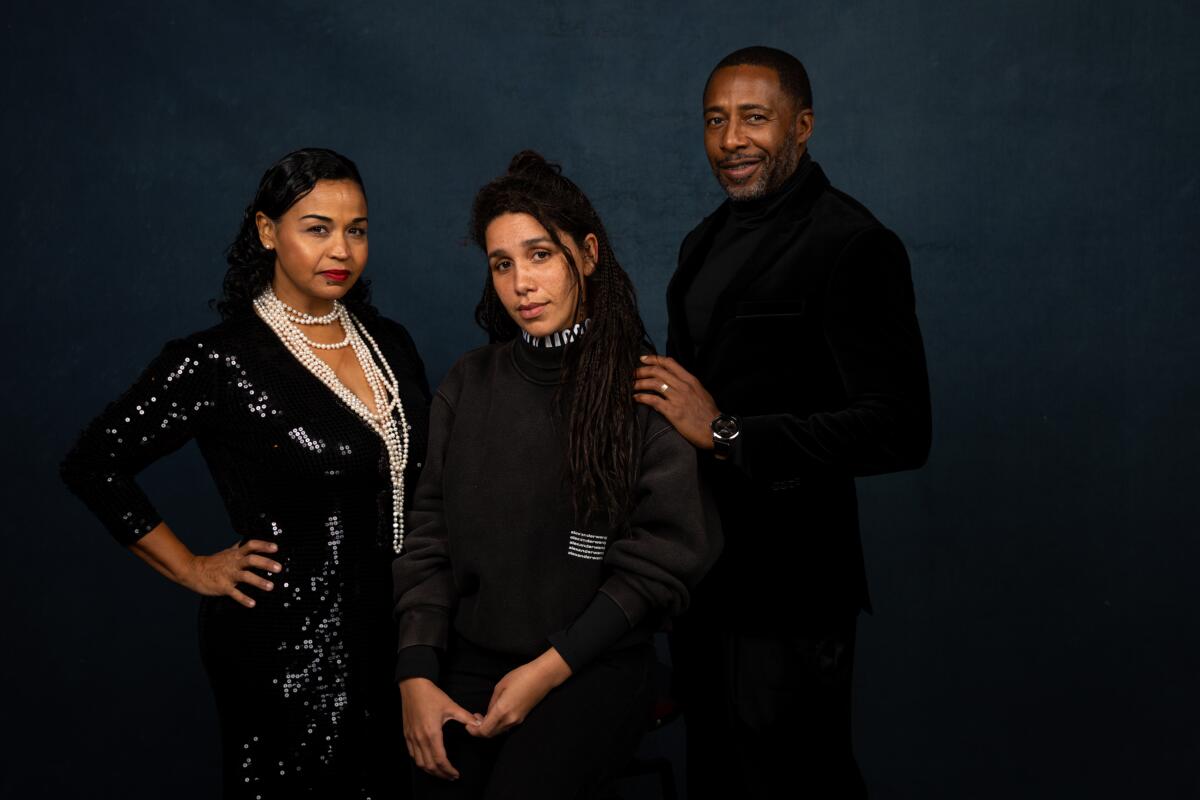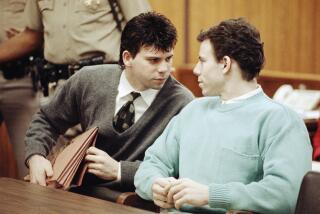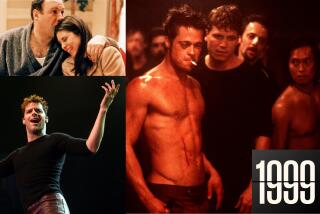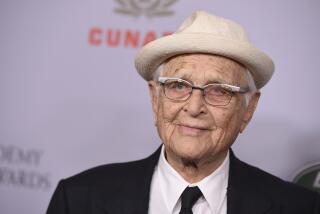‘Time,’ a kiss, and resilience as resistance: Why the Amazon documentary is a vessel for change
Sibil Fox Richardson and Robert Richardson were young newlywed parents in love in 1997 when they snuck a kiss during a car ride as her camcorder rolled on the dashboard, preserving in grainy image the kind of fleeting everyday moment most of us take for granted. Now etched in black and white in the new documentary “Time” from director Garrett Bradley, the moment is both memory and promise, a quiet gesture made epic and totemic by the decades of heartache that followed.
That’s because six months after that day, the world came crashing down on the Richardsons, who now go by Fox and Rob G. Rich, when the Shreveport, La., couple took part in a botched bank robbery that sent both of them and their nephew to prison.
Released after serving 3 ½ years behind bars, Fox set out to keep their young family together and began the long and arduous fight to bring her husband home. Raising their six sons with the help of her mother, she rebuilt her life, working to keep Rob’s memory present as he served a 60-year sentence in the Louisiana State Penitentiary. And for the next two decades, as she fought steadfastly for his freedom, she kept picking up her camera to film precious moments for him to see one day.
Fox Rich’s 21-year battle to free her husband from incarceration is at the heart of Garrett Bradley’s Sundance prize-winning movie “Time.”
“To continue filming was a form of resistance — to say, ‘We messed that up, but we can fix it, and we’re going to. And we’re going to stay diligent about it until we get it fixed,’” said Fox, whose story and personal archives provide the beating heart of “Time,” which is now streaming on Amazon. “I wanted to make sure that he would not be forgotten, which is what prison does to families. It takes human beings. It tucks them away and hides them from the rest of the world, and that was not going to happen to my family.”
But 18 years into his sentence Rob had yet to come home. No one, including Fox herself, had ever watched the home videos she’d shot over the years as their sons grew from boys into accomplished young men. Rich had relocated the family to New Orleans and become an entrepreneur, prison abolitionist and public speaker, all the while fighting through legal quagmires in hopes of winning his release. The family focused on forging ahead with a singular goal in mind which the Riches imparted to their sons.
“One of the lessons we tried to teach them is that success is the best revenge,” said Fox. “How do you get somebody back that’s trying to destroy you? You succeed anyhow.”
Fox first met Bradley when she appeared in the filmmaker’s 2017 short documentary “Alone,” which followed a young woman named Aloné Watts as she weighed the decision to marry her incarcerated boyfriend. Like “Time,” “Alone” stemmed from a personal connection to the people Bradley was filming, whom she had befriended while making her first narrative feature, “Below Dreams.”
“It became clear that there needed to be a conversation around incarceration that was rooted in the effects of it, that was talking about the issue from a place that was inherently familial — and that was maybe even inherently feminist,” Bradley said of “Alone,” which won the Sundance Short Film Jury Award in 2017 and was shortlisted for the Oscars.
In that documentary, Fox made a stirring appearance drawing a vivid connection between the prison industrial complex and the legacy of slavery in America.
“This system breaks you apart,” she advises Watts in the film. “Instead of using the whip, they use mother time. They use hardships. They may not hang you from the tree, but the experience itself is just like when they used to hang people — but barely hang them — and leave their feet just tiptoeing around in the mud, so that they’re constantly on their tiptoes fighting for their life. That is a daily experience when you are an incarcerated family.”
She and Bradley bonded instantly, and the 34-year-old filmmaker began a yearlong project documenting the Rich family for what she envisioned as a short companion piece to “Alone.” On the final day of filming, as the filmmaker packed up her gear, Fox handed her an unexpected treasure trove: A small black bag filled with dozens of miniDV tapes that held 100 hours of footage she’d shot over the course of 21 years.
“She said, ‘Maybe this will be useful to you — I haven’t watched it since I shot it in the ‘90s,’” Bradley remembered.
There are moments [in Fox’s videos] where she’s placing the camera in exactly the same place that I put the camera 19 years later. It’s like the images are actually collaborating with each other.
— Filmmaker Garrett Bradley
What Bradley found on those tapes opened unimaginable new possibilities for the project. Interweaving Fox’s personal archive with her own footage, she and editor Gabriel Rhodes expanded what was originally meant to be a 13-minute film into her 81-minute feature-length documentary debut — a black-and-white experimental meditation on love and radical resilience, centered around Fox’s decades-long fight to free Rob and make their family whole again.
A work of intimacy, poetry and power, “Time” drew acclaim in its January world premiere at the Sundance Film Festival, where Bradley became the first Black woman to win the U.S. documentary directing award.
To her, the film shares DNA with both “Alone” and her 2019 experimental short “America,” a work that builds from rare and recently rediscovered footage from the unreleased 1914 Bert Williams silent film “Lime Kiln Club Field Day,” thought to be the oldest surviving feature film with an all-Black cast and an integrated production team.
In that footage, which she interspersed with her own black-and-white vignettes, she saw a powerful example in vaudevillian star Williams, who achieved the near-impossible over a century ago at a time when even creating such a film as a Black artist was politically, practically and creatively challenging.
“I chose moments that I felt would make it unavoidable, that would prove what I knew inherently, and also to think about performance as an example of both oppression and resistance all in one,” said Garrett, who will present “America” as a video installation this fall in her first solo exhibition in New York, a partnership between the Museum of Modern Art and the Studio Museum in Harlem. “That nuance is the story of being Black and American. That existence is known to all of us.”
Similarly, she saw in Fox’s archive of self-made images a version of the woman she knew in the present. The material helped Bradley paint a fuller portrait of Fox’s life and character across time, blending serendipitously with her contemporary footage.
“With Fox, what was important to me was to honor who she was,” said Bradley, who spent time with both of the Riches before filming to understand what was important to them in the telling of their lives. “The images themselves, where the true collaboration was happening, were something that was completely cosmic. There are moments [in Fox’s videos] where she’s placing the camera in exactly the same place that I put the camera 19 years later. It’s like the images are actually collaborating with each other.”
And what had inspired Fox to start filming in the first place? “I had finally married the love of my life, and that’s when I picked up a camera,” she said. “When we were in the car and I looked at us, I was the happiest I had ever been in my life. I wanted to capture what I thought was the most beautiful thing I had created, and that was my family.”
On-screen in “Time,” the Riches saw themselves move backward and forward in time in the blink of an eye as Fox’s camera entwined with Bradley’s contemporary lens on their lives. They watched a young Fox in her 20s, pregnant with twins Freedom and Justus, smiling into the camera in anticipation of Rob’s release — and in later years, erecting a cardboard cut-out of him at home dubbed “Flat Rob” to ensure that his presence would always be felt.
There were birthdays, visitations, school awards, graduations; endless phone calls and legal filings that seemed to go nowhere, year after year. So much time spent and lost. For everyone, including Fox, watching Bradley’s film was the first they’d seen of the video diaries she’d kept all those years ago.
“One of the things that I heard them say after the film was, ‘Wow, I didn’t even realize we had been through all of that,’” Fox said of her children last week from New Orleans, beaming through happy tears as Rob sat by her side, squeezing her in an embrace. “Our son calls [Bradley] an honorary Richardson. At Sundance she officially became a member of the family.”
I had finally married the love of my life, and that’s when I picked up a camera ... I wanted to capture what I thought was the most beautiful thing I had created, and that was my family.
— Fox Rich
Rob, who was released early through clemency in 2018, says that the film’s release has been both “bittersweet” and “therapeutic.”
“When you’re fighting to undo a 60-year sentence, or an unjust sentence, the act of doing so keeps you in the heat of battle so you’re never really focused on whether or not someone else is watching — you’re just trying to get free,” he said. “It was only after my relief that any of us have really been able to lift our heads and pay any respect to what we actually experienced and overcame.”
He smiled. “Watching us all over space and time and seeing how much some of the cornerstone pieces of who we were as individuals didn’t get lost in our stint of incarceration, that was remarkable to me.”
After spending so many years apart, he and Fox are not shy about the joyous and surprising moment of intimacy Bradley captured the day Rob was released from prison. “It was not about the cameras, it was not about the documentary, it was about, this is the first time in 21 years that I can touch my husband,” Fox grinned. “Nothing else matters.”
They’d learned over the decades how even something as simple as a kiss can be an act of both love and defiance. More than 20 years after filming that brief moment in the car, they gave it a name: “The Kiss.” Each time they see it now, frozen in time and opening and closing Bradley’s film, they’re reminded how even casual caresses had been forbidden to them during Rob’s two decades of incarceration.
“I think about how for 21 years we used to sneak kisses in visitation,” said Fox, tearing up. “You’re only allowed one kiss when you come and you get one kiss when you go. So now, to be depicted all over the world kissing my love, is such bliss.”
“Of all of the images they could have chosen for the billboard and the poster of the film, they chose to depict Fox and I kissing one another,” said Rob. “Now here we are in newspapers, on billboards, everywhere, all over the world. It’s humbling, to say the least.”

Despite the film’s release, they emphasize, their work to free themselves and others from the American carceral system continues. As their story reaches new audiences they hope to keep conversations going around the experiences of the 2.3 million incarcerees in America, as well as advocate for the clemency process that sent Rob home.
“The biggest thing for me is getting people to understand that clemency works,” said Fox. “It is often the last course of redress for many families just like mine. We talk about criminal justice reform and passing legislation, but the truth be told, with the power of the pen from our state’s governor, they can instantly reduce our prison population.”
Through their community organization, Participatory Defense Movement NOLA, they teach legal awareness “as the best form of defense to injustice,” according to Rob, whose family continues to fight for the release of his nephew, who remains incarcerated on a 45-year sentence.
“We have an obligation to our family to bring him home,” said Fox. “So you rejoice in the moment and you are grateful, but there’s still so much more work to do.”
“For me, to be free is to free others,” she said. “So when you get an opportunity at freedom, especially how we had to really scrap and fight to get this opportunity at freedom, then you have an obligation. I’m just honored that we could be the vessel to tell this story of 2.3 million American families. This is, by far, not just our story.”
More to Read
Only good movies
Get the Indie Focus newsletter, Mark Olsen's weekly guide to the world of cinema.
You may occasionally receive promotional content from the Los Angeles Times.







